|
|
|
Sort Order |
|
|
|
Items / Page
|
|
|
|
|
|
|
| Srl | Item |
| 1 |
ID:
101168
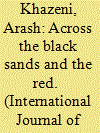

|
|
|
|
|
| Publication |
2010.
|
| Summary/Abstract |
Through a reading of 19th-century Persian travel narratives, this article locates the history of Iran and Central Eurasia within recent literature on global frontier processes and the encounter between empire and nature. It argues that Persianate travel books about Central Eurasia were part of the imperial project to order and reclaim the natural world and were forged through the material encounter with the steppes. Far from a passive act of collecting information and more than merely an extension of the observer's preconceptions, description was essential to the expansion and preservation of empire. Although there exists a vast literature on Western geographical and ethnographic representations of the Middle East, only recently have scholars begun to mine contacts that took place outside of a Western colonial framework and within an Asian setting. Based on an analysis of Riza Quli Khan Hidayat's Sifaratnama-yi Khvarazm, the record of an expedition sent from the Qajar Dynasty to the Oxus River in 1851, the article explores the 19th-century Muslim "discovery" of the Eurasian steppe world. The expedition set out to define imperial boundaries and to reclaim the desert, but along the way it found a permeable "middle ground" between empires, marked by transfrontier and cross-cultural exchanges.
|
|
|
|
|
|
|
|
|
|
|
|
|
|
|
|
| 2 |
ID:
082111
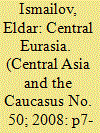

|
|
|
| 3 |
ID:
124876
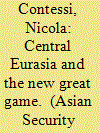

|
|
|
|
|
| Publication |
2013.
|
| Summary/Abstract |
In the 20 years since independence from the former Soviet Union, the study of Eurasia in International Relations (IR) has received considerable impetus in both the academic and policy circles. Specialized news and analysis outlets have come online, research centers have multiplied within universities, and a variety of think tanks now host dedicated programs. In other words, this still relatively little-known region has glamour. Yet Eurasia remains difficult to situate as an object of study due to its distinctive hybridity: geographical, at the crossroads between Europe and Asia; cultural, Muslim Russianspeaking Turkic peoples with Asian traits and traditions; political, straddling Western and Asian institutional forms domestically, and contiguous to Europe, Asia, Russia, the Middle East, and Afghanistan internationally. Partly as a result of this hybridity, Eurasia is a somewhat elusive object of study. At a minimum, it comprises the two subregions on each shore of the Caspian basin: Central Asia to the east and the Caucasus to the west. Reflecting this elusiveness, Central Asian states (CAS) belong to the Asia-Pacific Regional Group at the United Nations; they are members of the Asian Development Bank and the Economic Commission for the Asia-Paci?c. At the same time, they are members of the Organization for Security and Cooperation in Europe (OSCE), the European Bank for Reconstruction and Development, and the Euro-Atlantic Partnership Council, a North Atlantic Treaty Organization (NATO) ancillary forum. But they also have distinctly Central Asian groupings, such as the Eurasian Development Bank, the UN-af?liated Central Asian Regional Information and Coordination Center, not to mention the Shanghai Cooperation Organization (SCO) and Collective Security Treaty Organization (CSTO). Similarly, the three Caucasian states share most of the same af?liations, except for belonging to the East European Regional Group at the UN
|
|
|
|
|
|
|
|
|
|
|
|
|
|
|
|
| 4 |
ID:
101186
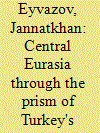

|
|
|
| 5 |
ID:
096048
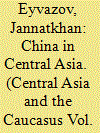

|
|
|
| 6 |
ID:
062767
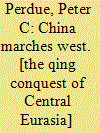

|
|
|
|
|
| Publication |
Cambridge, Harvard University Press, 2005.
|
| Description |
xix, 725p.Hbk
|
| Standard Number |
067401684X
|
|
|
|
|
|
|
|
|
|
|
|
Copies: C:1/I:0,R:0,Q:0
Circulation
| Accession# | Call# | Current Location | Status | Policy | Location |
| 049767 | 951.03/PER 049767 | Main | On Shelf | General | |
|
|
|
|
| 7 |
ID:
184481
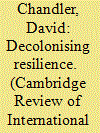

|
|
|
|
|
| Summary/Abstract |
In dominant Eurocentric policy imaginaries, a resilient community is able to self-govern and to autonomously manage risk through becoming more adaptive and responsive to potential threats, mitigating harms and maintaining societal equilibrium; ‘bouncing back’ rapidly to normal conditions. This paper seeks to move the discussion forward, suggesting alternative framings for the conceptualisation of community practices and understandings as part of the project of decolonising approaches to Central Eurasia. In drawing upon recent works addressing resilience via Édouard Glissant’s Poetics of Relation, it highlights alternative understandings of resilience which are less subject-centred and more dependent upon becoming with others in relation. Crucial to these practices of relationality is the recognition of opacity - the acceptance that uncertainty and unknowability are integral to life processes and provide a vital invitation or opportunity to experiment and adapt through improvisation rather than mechanically responding to feedback effects in ways which close off alternative possibilities for change.
|
|
|
|
|
|
|
|
|
|
|
|
|
|
|
|
| 8 |
ID:
157600
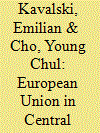

|
|
|
|
|
| Summary/Abstract |
The foreign policy statements of the European Union (EU) have long been positioning it as a global normative power. Yet, its ability to “Europeanize” international affairs has rarely been examined outside of the EU enlargement framework. In this respect, the EU’s initiatives in Asia offer a relevant context for the consideration of its global outreach. In order to examine whether the EU has been able to catalyze the global relevance of its normative power, this study undertakes a parallel assessment of its engagement with the countries of Central Asia and Afghanistan. The suggestion is that the cultural instincts of the EU’s normative power entrap its agency in Central Asia and Afghanistan and make it difficult for Brussels to develop a coherent strategy not only in the region, but also in Asia.
|
|
|
|
|
|
|
|
|
|
|
|
|
|
|
|
| 9 |
ID:
140139
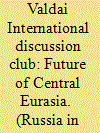

|
|
|
|
|
| Summary/Abstract |
The year 2014 saw Russia turn towards the East, establish a genuine strategic partnership with China, and embark on a radical transformation of its relations with the West. These historic changes coincided with the beginning of a new stage in Eurasian integration and the advancement of several strategic initiatives by Beijing. The most important of them is the Silk Road Economic Belt concept, a large-scale investment and transport/logistics project, announced in 2013.
|
|
|
|
|
|
|
|
|
|
|
|
|
|
|
|
| 10 |
ID:
100632
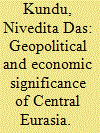

|
|
|
| 11 |
ID:
147734
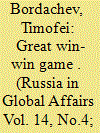

|
|
|
|
|
| Summary/Abstract |
On June 5, 2016, a group of armed militants attacked National Guard weapons depots and barracks in the city of Aktobe, north-western Kazakhstan, some 253 kilometers from Russia's Orenburg. Several dozen people, including the attackers, died in the clash. Siloviki, a term commonly used in post-Soviet countries for security and law enforcement agencies, did not hide their perplexity over what had happened, and foreign observers commented that the situation in Kazakhstan, long seen as a model of stability among the southernmost former Soviet republics, might deteriorate sharply. These events highlight the need for a discussion on broad international cooperation to ensure regional stability, create new institutional formats, and foster collaboration among CSTO and SCO structures.
|
|
|
|
|
|
|
|
|
|
|
|
|
|
|
|
| 12 |
ID:
175385
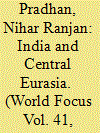

|
|
|
|
|
| Summary/Abstract |
The situation in Central Asia has undergone a sweeping change since 9/11. The region became a pivotal theatre for war against terrorism that enhances its importance internationally. India’s security concerns were inextricably linked to the turbulence in Central Asia, especially in the context of Pakistan and the instability in Afghanistan. Therefore, India has to look afresh to the region.
|
|
|
|
|
|
|
|
|
|
|
|
|
|
|
|
| 13 |
ID:
143121
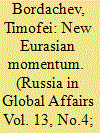

|
|
|
|
|
| Summary/Abstract |
Central Eurasia is embarking on a major transformation to change its economic and political system. The growing rapport between Russia and China, progressing Eurasian integration, and Beijing's reciprocal trade and investment initiatives have added new dynamics to this process. The implementation of the joint statement of the presidents of Russia and China on the integration of the Eurasian Economic Union (EAEU) and the Silk Road Economic Belt (SREB) projects helps not only identify areas of cooperation within the EAEU and with China, but also assess related challenges.
|
|
|
|
|
|
|
|
|
|
|
|
|
|
|
|
| 14 |
ID:
127612


|
|
|
|
|
| Publication |
2013.
|
| Summary/Abstract |
It is hardly possible to correctly and fully assess the functioning and development of a regional security system without presenting a complete account of the entire range of ties and relations among the actors involved and the degree of influence of all the powers concerned.
Based on a case study of the post-Soviet space, the author studies the involvement of powers in regional security systems; his analysis of the key parameters of this involvement makes it possible for him to identify and describe two types of involvement: full and partial.
|
|
|
|
|
|
|
|
|
|
|
|
|
|
|
|
| 15 |
ID:
169250
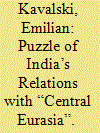

|
|
|
|
|
| Summary/Abstract |
India’s relations with Afghanistan and the post-Soviet countries of Central Asia have contributed to the growing interest in the country’s rise. By treating them together as “Central Eurasia,” the discourses of Indian foreign policy invoke a contiguous geopolitical locale bound to India by a shared past. Yet, despite the strategic articulation of a manifest Central Eurasian region, the article uncovers a puzzle of bifurcation in India’s foreign policy reflecting distinct operationalizations of India’s cultural capital in its relations with Afghanistan and the Central Asia republics. The comparative analysis indicates that prior historical experience becomes a compelling strategic context for the continuous framing and reframing of the country’s foreign policy space, which reveals India’s shifting perceptions of international order, self-identity, and global roles. India’s interactions in Central Eurasia offer a good illustration of the crossroads that New Delhi’s foreign policy is facing – either keep on proliferating discourses that spin yarns of the international influence of its historical capital or develop proactive diplomatic strategies that deliver the international status that India desires.
|
|
|
|
|
|
|
|
|
|
|
|
|
|
|
|
| 16 |
ID:
067359
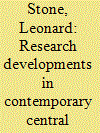

|
|
|
| 17 |
ID:
070008
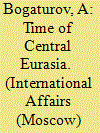

|
|
|
| 18 |
ID:
134142
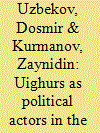

|
|
|
|
|
| Publication |
2014.
|
| Summary/Abstract |
In the Middle Ages, the Uighurs, who are one of the oldest and largest peoples of Central Eurasia (CE), were driven into East Turkestan and then conquered by the Qing Empire. The Chinazation policy carried out in relation to these people led to the mass exodus of the freedom-fighting Uighurs to the CE countries.
The Uighurs are vigorously engaged in economic activity; in other spheres they are traditionally closed and alienated from the outside world, which prevents them from becoming actively integrated into contemporary society.
This article analyzes the roots and reasons for this social phenomenon, which is having a certain influence on the foreign and domestic policy of the Kyrgyz Republic (KR), as well as on political stability and security of the entire Central Asian region.
|
|
|
|
|
|
|
|
|
|
|
|
|
|
|
|
|
|
|
|
|